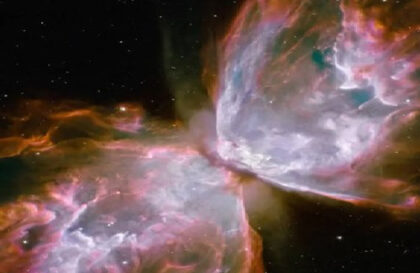8,100 stars formed a 9.5 light-year-long spire of cold gas. Among them is the double star HD 168076, with a mass of 80 solar masses and a luminosity 1 million times greater than the Sun. This cluster is approximately 1–2 million years old. Meet the brightest part of the Eagle Nebula, another name for the Star Queen Nebula.
The M16 is a majestic tower of cold gas and tiny dust particles rising from the Eagle Nebula. This floating tower spans 9.5 light years (about 90 trillion kilometers long), twice the distance from the Sun to our nearest star, Proxima Centauri.
Within this gas tower lies the potential for the birth of new stars. Some may arise from the collapse of dense gas under gravity, while other stars will form under the influence of gas pressure heated by nearby hot stars.
This haunting spire, captured by Hubble in visible and infrared light, is composed of cold gas and dust within M16. Stretching 9.5 light-years, this tower spans more than twice the distance from our sun to its nearest star. Radiation from the hot young stars in the top half of the image is illuminating and eroding the structure. Credit: NASA, ESA, and the Hubble Heritage Team (STScI/AURA)
The surface of this tower, multifaceted and rough, is illuminated by the soft light of the stars, and its contours are outlined against the background of the glow of a distant gas cloud. The colors in this image come from gas excited by the star cluster’s powerful ultraviolet radiation. The blue hue at the top of the tower comes from glowing oxygen, while the red tones at the bottom are associated with the radiation of burning hydrogen.
Three-colour composite mosaic image of the Eagle Nebula, with north at the top. Credit: ESO
A nebula is a distinct luminescent portion of the interstellar medium that may consist of ionized, neutral, or molecular hydrogen and cosmic dust. Nebulae are often regions of star formation, such as in the “Pillars of Creation” in the Eagle Nebula.
Banner image: Wikipedia (Public source)
Image credit:
https://en.wikipedia.org
https://www.esa.int
https://sci.esa.intt






